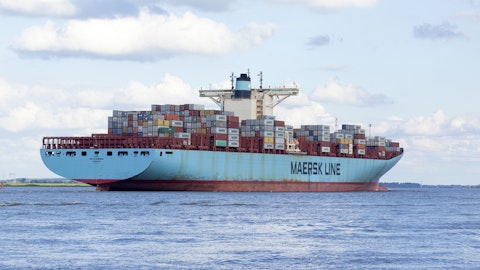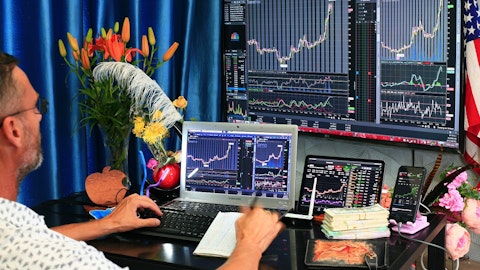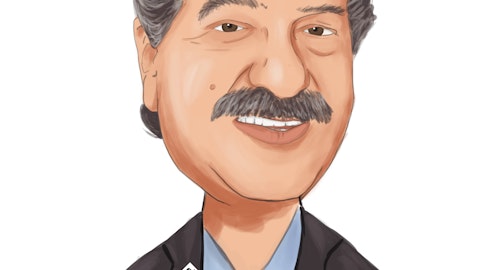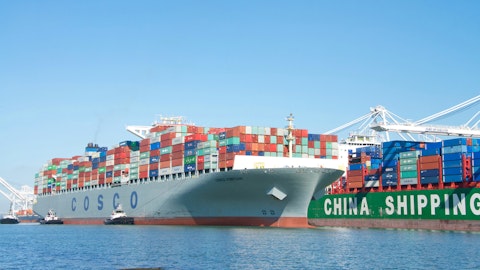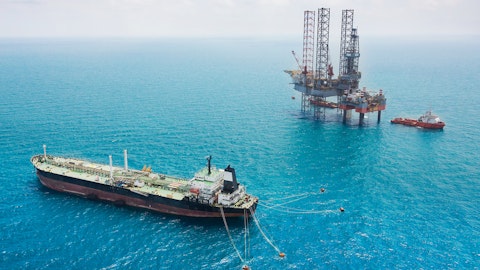Teekay Corporation (NYSE:TK) Q3 2023 Earnings Call Transcript November 3, 2023
Operator: Welcome to Teekay Tankers Ltd Third Quarter 2023 Earnings Results Conference Call. During the call, all participants will be in a listen-only mode. Afterwards, you will be invited to participate in a question-and-answer session [Operator Instructions]. As a reminder, this call is being recorded. Now for opening remarks and introductions, I would like to turn the call over to the company. Please go ahead.
Unidentified Company Representative: Before we begin, I would like to direct all participants to our website at www.teekay.com, where you will find a copy of the third quarter 2023 earnings presentation. Kevin and Stewart will review this presentation during today’s conference call. Please allow me to remind you that our discussion today contains forward-looking statements. Actual results may differ materially from results projected by those forward-looking statements. Additional information concerning factors that could cause actual results to materially differ from those in the forward-looking statements is contained in the third Quarter 2023 earnings release and earnings presentation available on our website. I will now turn the call over to Kevin Mackay, Teekay Tankers’ President and CEO, to begin.
Kevin Mackay: Thank you, Ed. Hello, everyone, and thank you very much for joining us today for Teekay Tankers’ third quarter 2023 earnings conference call. Joining me on the call today are Stewart Andrade, Teekay Tankers’ CFO; and Christian Waldegrave, our Director of Research. Moving to our recent highlights on Slide 3 of the presentation. Teekay Tankers generated total adjusted EBITDA of approximately $106 million in the third quarter, up from the $92 million we generated in the same quarter of last year. We reported adjusted net income of approximately $77 million or $2.24 per share, an increase from last year’s third quarter levels of $58 million or $1.70 per share, respectively. Our significant operating leverage, combined with the historical high third quarter spot rates resulted in Teekay Tankers generating our highest ever third quarter adjusted net income.
As a reminder, for every $5,000 increase in tanker rates above our free cash flow breakeven of $16,000 per day, we expect to generate approximately $2.60 of annual free cash flow per share. We will provide further information of this later in the presentation. In line with our fixed quarterly dividend policy, we have declared a cash dividend of $0.25 per share for the third quarter of 2023. As previously announced, we completed the repurchase of four vessels, which were on sale leaseback arrangements for $57 million. These vessels were financed with our $350 million revolving credit facility. In the market, rates remained firm on a historical basis with average mid-size rates the highest for a third quarter in 15 years. These high average spot rates were achieved despite spot tanker rates declining in the second half of the quarter due to a combination of reduced exports from OPEC+ and normal seasonality.
Spot tanker rates have, however, firmed significantly once again through the early part of the fourth quarter, and we believe the increased tanker demand and seasonal factors will continue to support rates through the winter months. While seasonality and geographical factors will continue to play a role, tanker market fundamentals point to continued strength over the next two years to three years, underpinned by a very positive fleet supply outlook. Finally, we extended one in-charter vessel for an additional 12 months at a rate of $21,250 per day. Our in-charter fleet of eight vessels now has an average charter-in rate of $25,400 per day, and the company also has two vessels chartered out at an average of $43,500 per day. Turning to Slide 4, we look at third quarter dynamics in the spot tanker market.
Spot tanker rates remained historically firm during the third quarter, though rates fell during the second half of the quarter due to reduced exports from the OPEC+ group and normal seasonality. Saudi Arabia announced a voluntary supply cut of 1 million barrels a day in July 2023 and has pledged to keep these cuts in place to the end of the year, which has negatively impacted crude tanker demand for larger ships. In addition, Russian crude oil exports fell during the third quarter as higher Russian domestic demand during the summer resulted in less crude oil available for export. Seasonal factors also played a part, with lower crude demand from refineries during the quarter due to normal seasonal maintenance. Despite these factors, tanker rate averages remained firm on a historical basis, with TNK recording the best mid-size tanker spot rates for a third quarter in the past 15 years.
At the start of Q4, spot tanker rates have increased sharply as seaborne crude oil volumes have increased, as shown by the chart on the right of the slide. We believe that this marks the start of the seasonally strong winter market, and we will give more detail of our outlook for the coming months later in the presentation. Turning to Slide 5, we provide an update on our Suezmax and Aframax size spot rates in the third quarter-to-date. Based on approximately 42% and 37% of revenue days booked, Teekay Tankers’ third quarter-to-date Suezmax and Aframax size vessel bookings have averaged approximately $26,500 per day and $38,800 per day, respectively. As you’ll see from the green dots on the chart, the current reported rates from Clarksons are now sharply higher, which speaks to the tightness in the tanker market and the effect of increased seaborne crude volumes.
As voyages agreed during the latter part of Q3 and early October are completed and replaced by those reflecting the more recent higher spot market, we expect our own spot rate results to strengthen as we move further through the quarter, provided rates remain firm. Importantly, I would highlight the value being created by TNK’s eight-vessel chartered-in fleet, with six trading in the strong spot market with an average in-charter rate of $25,400 per day. The chartered-in fleet has a current mark-to-market value of approximately $56 million. Turning to Slide 6, we look at our outlook for the upcoming winter tanker market. As mentioned earlier, spot tanker rates have risen sharply at the start of the fourth quarter. One of the main drivers has been an increase in crude oil exports from key load regions, including a reversal of supply cuts from both Russia and Saudi Arabia.
As shown by the chart on the left, Russian crude oil exports have recovered from a low of 3.1 million barrels per day in July to 3.5 million barrels per day in October. With over 90% of these volumes heading long-haul to India and China on Aframaxes and Suezmaxes, this increase has resulted in the return of significant mid-size tanker demand, as we saw earlier in the year. Similarly, crude oil exports from Saudi Arabia have increased from a low of 5.5 million barrels per day in August to an average of 6.5 million barrels per day in October. This increase comes despite Saudi Arabia’s voluntary production cut of 1 million barrels per day remaining in place, as lower domestic demand and refinery maintenance have made more oil available for export.
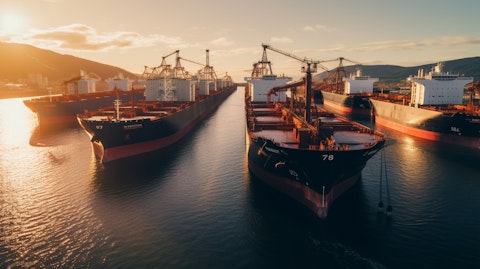
Crude oil exports have also been strong from other key mid-size tanker load regions, such as the US Gulf and West Africa. The removal of US sanctions on the Venezuelan oil industry could give a further boost in the coming months, as more oil is expected to flow to the US and Europe on mainstream Aframax and Suezmax tonnage at the expense of movements to China on the dark fleet. Higher refinery throughput should also support crude tanker demand in coming months, as refiners increase their crude purchases ahead of the winter demand season. As shown by the chart, the IEA expects the global refinery throughput will increase by 2.4 million barrels per day between October and December, which should be positive for tanker demand. Normal winter market factors such as weather delays are expected to give further support to rates by tightening available vessel supply, as is normal during the fourth and first quarters of the year.
Turning to Slide 7, we highlight the positive tanker supply fundamentals, which we believe will underpin a strong tanker market over the next two years to three years. Firstly, the tanker order book remains close to historic lows at just under 6% of the existing tanker fleet size. As per Clarksons, global shipyard forward cover currently stands at three and a half years, the highest level since 2009, with 90% of the order book comprising vessels other than tankers. This means that the delivery of the small tanker order book will be spread out over a longer-than-normal period and that there are limited berths available for additional deliveries prior to 2027. While we acknowledge that pace of tanker ordering has increased in 2023 compared to last year’s historical low levels, this increase needs to be put into context.
Just under 24 million deadweight tons of new tanker orders has been placed to date during 2023, which is in line with the average level of newbuild ordering over the last 20 years. Furthermore, the tanker fleet is aging, with a significant portion of the fleet reaching potential replacement age in the next few years. At present, 11% of the mid-size tanker fleet is aged 20 years or older, with another 14% reaching age 20 between 2024 and 2026. The combination of a smaller tanker order book, an aging tanker fleet, and a lack of shipyard capacity are expected to lead to very low levels of tanker fleet growth for at least the next two years to three years. Using our internal ship supply forecast model, which is based on the current order book and assumes very conservative levels of ship recycling, we project that less than 1% fleet growth in 2024 and 2025, and negative fleet growth in 2026.
I’ll now turn the call over to Stewart to cover the financial slide.
Stewart Andrade: Thanks, Kevin. Turning to Slide 8, we highlight the significant shareholder value and increasingly strategic optionality being created by Teekay Tankers. With almost all of TNK’s 53 vessel fleet trading in the firm spot market, our high operating leverage once again enabled us to generate substantial free cash flow. In the third quarter, which had seasonally lower rates, particularly in August, we generated $98 million of free cash flow. If Q3 2023 spot rates are forecast for the next 12 months, we would expect to generate about $350 million in annual free cash flow, or $10.25 per share annually, equating to a free cash flow yield of approximately 20%. Generating almost $100 million of shareholder value in the seasonally weakest quarter of the year clearly demonstrates how well Teekay Tankers is positioned to create value in this market.
Considering a full year of spot rates, the chart on the slide also shows our forecast annual free cash flow based on average spot rates achieved by Teekay Tankers in the last 12 months. With these rates, TNK is forecast to generate over $18 per share of annual free cash flow, equating to a free cash flow yield of approximately 36%. With the tanker market now in its sixth consecutive strong quarter, and with the market fundamentals pointing towards sustained strong market, we believe the company is very well positioned to continue creating shareholder value and strategic optionality. In terms of our financial position, we have leveraged our strong cash flow generation and our increasing financial strength to further optimize our balance sheet.
Since March of this year, we have repurchased 19 vessels from sale-leasebacks for a total of $364 million. Refinancing these vessels into a revolving loan facility has allowed us to maintain readily available capacity to take advantage of opportunities while paying down debt balances and reducing interest expense. In addition, given our financial position, we elected to terminate our $80 million working capital loan facility. These steps have allowed us to further reduce our breakeven levels and increase value creation for our shareholders. Looking forward, we have eight vessels remaining in sale-leaseback arrangements, for which we have purchased options totaling $137 million, available beginning in the first quarter of 2024. While still dependent on market conditions, we anticipate exercising those options and completing that phase of our balance sheet optimization.
Finally, as mentioned on the last call, we are in a net cash position, which reached $83 million at the end of the third quarter. I will now turn the call back to Kevin to conclude.
Kevin Mackay: Thanks, Stewart. In summary, with vessel fleet growth that is essentially fixed at a very manageable level for the next few years, we see the potential for a strong and healthy extended run for the overall tanker market and for Teekay Tankers, in particular. Our spot market exposure, strong financial position, and focused participation in the mid-size crude segment is, in our view, putting us in a very good position over the next few years to capture both opportunities and added value for our company. With that, operator, we’re now available to take questions.
See also 10 Best Bank Penny Stocks to Buy Now and 12 Best Nano Cap Stocks To Buy Now.
Q&A Session
Follow Teekay Corp (NYSE:TK)
Follow Teekay Corp (NYSE:TK)
Operator: [Operator Instructions] And we’ll pause for a moment to allow everyone an opportunity to signal for questions. Our first question is coming from Jon Chappell with Evercore.
Jon Chappell: Stewart, if I can start where you left off, on the creating significant shareholder value and strategic optionality. Should we think about this 1Q ’24 eight remaining vessels on sale and leaseback kind of the clearing event? You’ve generated a ton of cash. The net cash position has continued to move up. The most delevered balance sheet in the industry. One special dividend, but maybe how do we think about capital allocation going forward? Do we just have to finalize this one last piece of the balance sheet restructure and then we can think about capital returns being ratcheted up?
Stewart Andrade: I see the final sale-leasebacks and acquiring those as really an incremental step as — in terms of optimizing the balance sheet and not really a major event, it’s just a progression. As we’ve said in our prepared remarks, we’re in a net cash position, and that’s not going to change significantly when we purchase those vessels back. We came out with the capital allocation plan six months ago, which, as you know, included a fixed dividend when we announced it. We also paid a $1 special dividend and we put a share buyback program in place. And I would say in broad terms that the market has unfolded roughly in line with what we expected when we put that in. We’ve been very bullish on the tanker market, and it’s delivered over the last six months.
So I don’t see any change in our capital allocation in the near term. Of course, we understand that shareholders are interested in a return of capital, and we have the tools in place to do that. Anything above our quarterly fixed dividend will be subject to discussions that we have with our Board and making decisions to return anything in addition to the $0.25 a quarter. And when we announced the policy, if you recall, we said that that’s something that we would likely do on a periodic basis, and that’s still our plan going forward.
Jon Chappell: And then just a follow-up to Kevin on strategic optionality. So asset values continue to move higher. You’ve just laid out a very optimistic view on the market for the next two years to three years, which would make me think that there is more willing buyers than willing sellers that continue to put pressure — upward pressure on asset values. When you think about the modernization of your fleet, could you also consider — and I think I asked this in a different way last quarter, so forgive me, but could you modernize the fleet by selling older tonnage at pretty premium prices as opposed to what I think some people fear is a rock and a hard place of going out and buying assets at a peak?
Kevin Mackay: Yes, I think it’s an arithmetic question. If you sell older assets, your average fleet age comes down. But the way we look at it is, what is the best thing to do with our fleet? And at this point in time, we’re extremely comfortable with where our fleet stands today. It’s in line with industry average profiles. It’s in a fantastic segment in the mid-size tanker space, and we’re benefiting from the ton-mile increases as a result of Europe banning the Russian imports. But the world — there’s a lot going on right now. And in our view, there’s really no rush to do anything. We’re really in a good position. So our forward view of the market is strong. We can continue to trade our assets for several years into the future without any difficulty.
We could — as you mentioned, we could also sell, and with asset prices being high, we keep our options open. If we’re offered a very nice opportunity to sell an asset and add incremental value above what our forward expectations are, we’ll obviously consider that. But it’s really a portfolio view that we take on the fleet and I don’t see the need with the strategy that we have, I don’t see the need right now to pull the trigger to do anything immediately.
